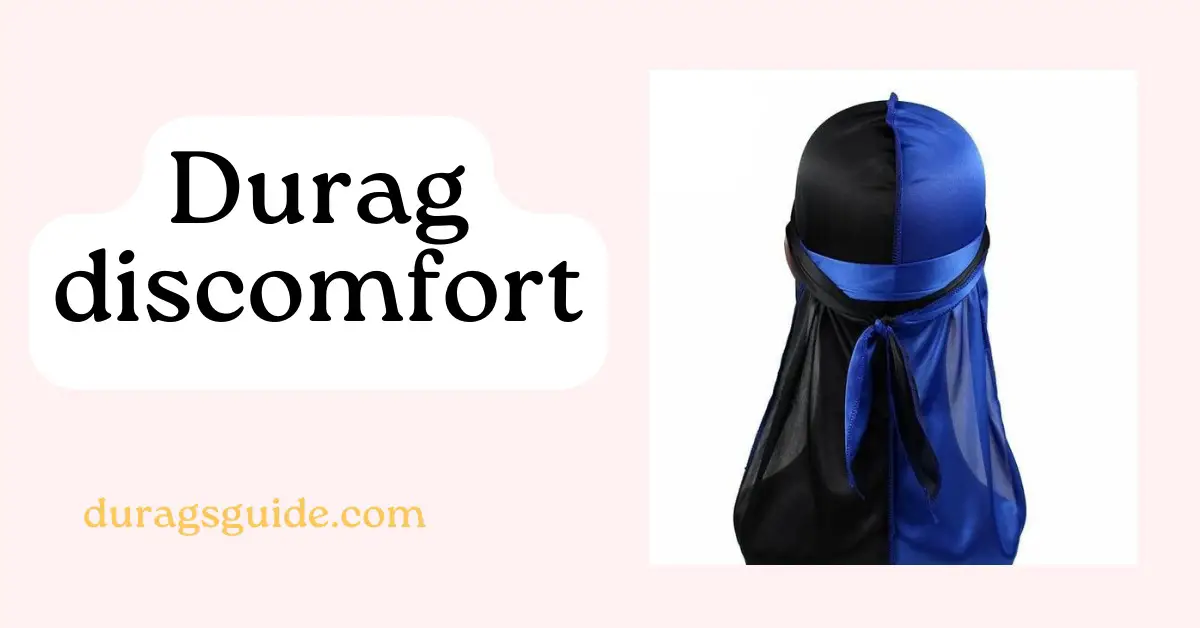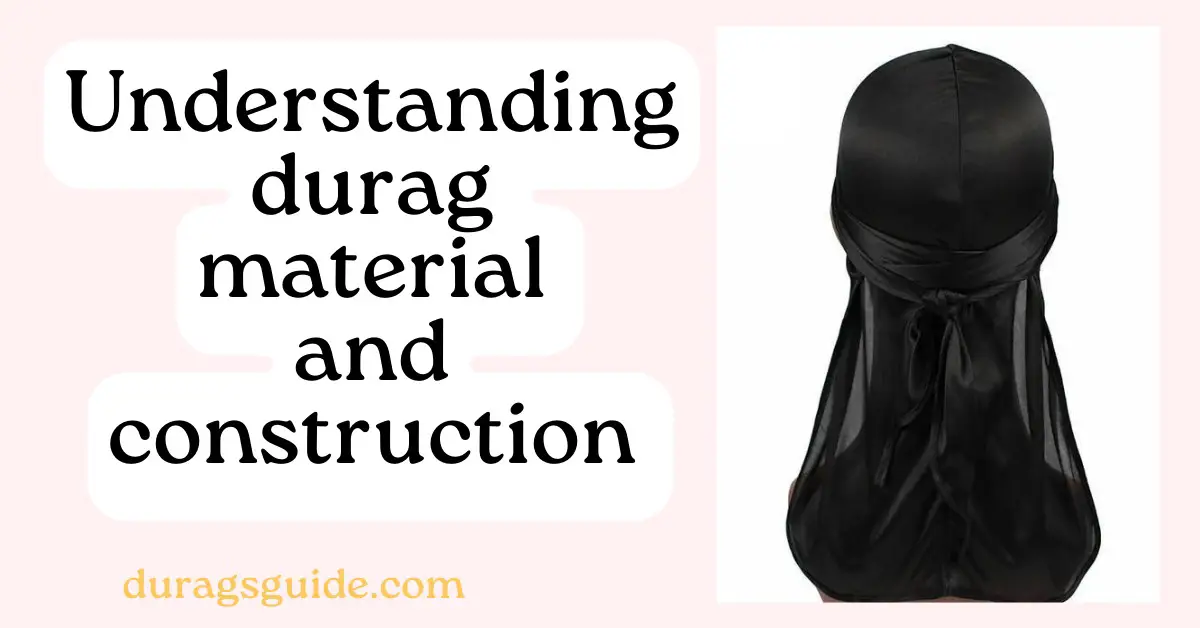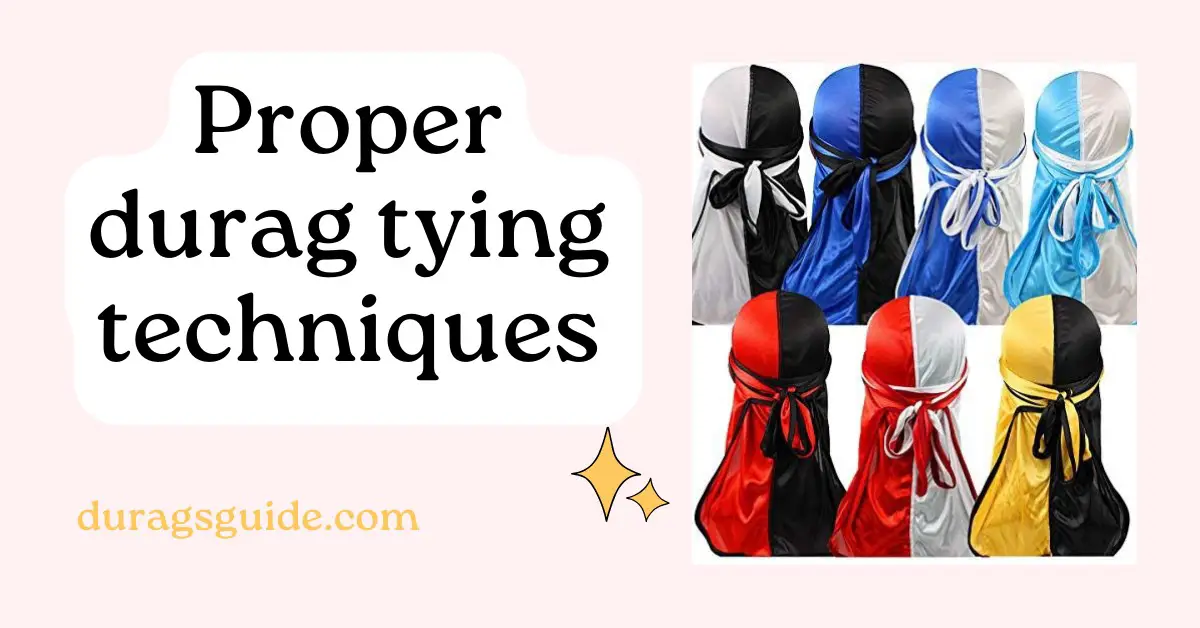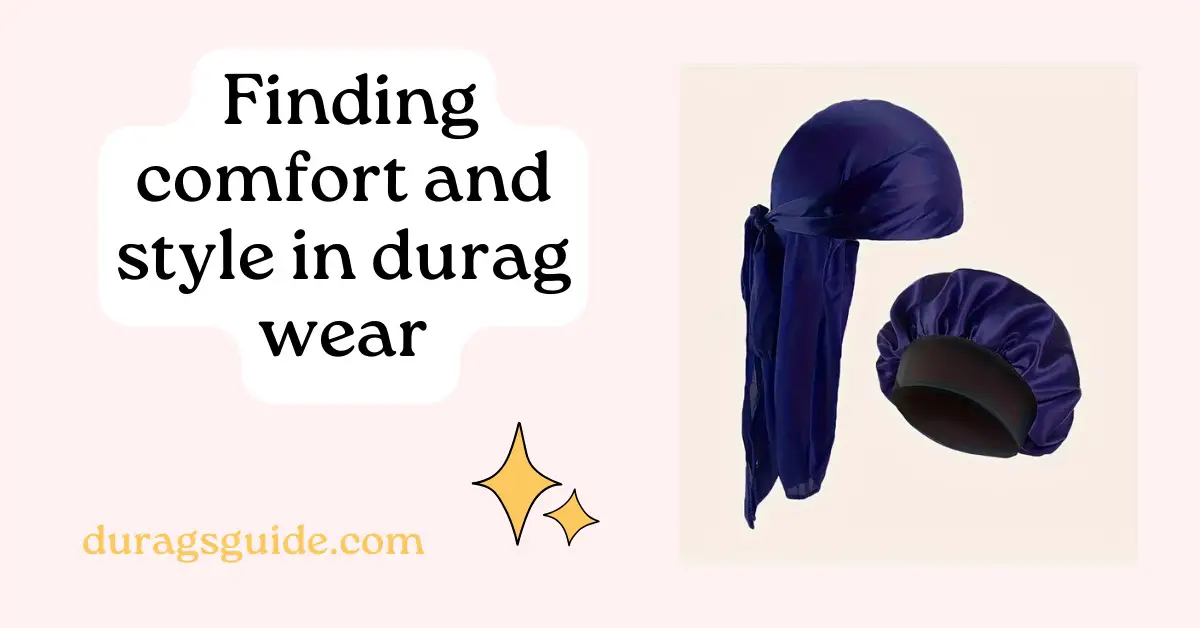Introduction
Are you experiencing discomfort while wearing your durag? You’re not alone. Many individuals encounter issues such as headaches, scalp irritation, and hair damage from improper durag usage. In this article, we’ll delve into the reasons Why Does My Durag Hurt My Head? An In-Depth Look and provide practical solutions to ensure a comfortable and enjoyable durag-wearing experience. Whether you’re new to durags or a seasoned wearer, read on to discover how to alleviate the pain and enhance your style.

Understanding Durag Discomfort
Wearing a durag can sometimes lead to discomfort, ranging from mild irritation to more significant issues like headaches or hair breakage. Understanding the factors contributing to this discomfort is essential for finding effective solutions.
1.1 Durag Material and Construction:
- The material and construction of the durag play a significant role in its comfort level.
- Some durags are made from stiff or rough materials that can rub against the scalp and cause irritation.
- Low-quality stitching or seams may dig into the skin and create discomfort.
1.2 Durag Fit and Size:
- A durag that is too tight can exert pressure on the scalp and cause headaches or discomfort.
- Conversely, a durag that is too loose may slip or move around, leading to irritation.
- Finding the right size and fit is crucial for ensuring comfort during wear.
1.3 Durag Tying Technique:
- The way a durag is tied can also impact comfort.
- Tying the durag too tightly can result in excessive pressure on the scalp.
- Improper tying techniques may lead to uneven distribution of tension, causing discomfort in specific areas.
1.4 Durag Duration of Wear:
- Wearing a durag for extended periods without relief can contribute to discomfort.
- Continuous pressure on the scalp and hair follicles may lead to soreness or irritation.
- Taking breaks from wearing the durag or adjusting its positioning periodically can help alleviate discomfort.

Factors Contributing to Durag Discomfort
Various factors can contribute to discomfort while wearing a durag. Identifying these factors is crucial for finding effective solutions and ensuring a comfortable durag-wearing experience.
2.1 Material Quality:
- The quality of the material used in a durag can significantly impact comfort.
- Low-quality materials may be rough, stiff, or abrasive, leading to skin irritation and discomfort.
- Opting for durags made from soft, breathable fabrics like satin or silk can enhance comfort and minimize irritation.
2.2 Size and Fit:
- Choosing the right size and fit is essential for preventing discomfort.
- A durag that is too tight can exert excessive pressure on the scalp, leading to headaches or soreness.
- Conversely, a durag that is too loose may not provide adequate support and may slip or move around, causing irritation.
2.3 Tying Technique:
- Improperly tying a durag can contribute to discomfort.
- Tying the durag too tightly can result in pressure points and discomfort.
- It’s essential to master proper tying techniques to ensure even distribution of tension and minimize discomfort.
2.4 Hair Type and Texture:
- Individuals with different hair types and textures may experience varying levels of discomfort while wearing a durag.
- Coarse or tightly coiled hair may be more prone to tangling or snagging on rough durag materials, leading to discomfort.
- Choosing durags specifically designed for your hair type can help minimize discomfort and promote a comfortable fit.
2.5 Duration of Wear:
- Prolonged wear of a durag without breaks can exacerbate discomfort.
- Continuous pressure on the scalp and hair follicles may lead to soreness, irritation, or headaches.
- Taking regular breaks from wearing the durag and allowing the scalp to breathe can help alleviate discomfort.
Tips for Choosing the Right Size Durag
Selecting the correct size durag is essential for ensuring comfort and effectiveness in preserving hairstyles. Here are some tips to help you choose the right size durag:
3.1 Measure Your Head:
- Before purchasing a durag, measure the circumference of your head using a soft tape measure.
- Measure around your forehead, just above your eyebrows, and around the widest part of the back of your head.
- Use these measurements as a guide when selecting the appropriate size durag.
3.2 Consider Your Hair Length:
- Individuals with longer hair may require a larger size durag to accommodate their hair volume.
- If you have short hair or a close-cropped hairstyle, a smaller size durag may provide a snugger fit.
3.3 Check Durag Sizing Charts:
- Many durag manufacturers provide sizing charts to help customers determine the best fit.
- Consult the sizing chart provided by the durag manufacturer and match your head measurements to the corresponding size.
3.4 Try Different Styles:
- Durags come in various styles, including standard, long-tail, and extra-long-tail designs.
- Experiment with different styles to find the one that offers the most comfortable fit for your head shape and hairstyle.
3.5 Consider Stretch and Elasticity:
- Some durags feature stretchy materials or elastic bands that can provide a more flexible and adjustable fit.
- Consider durags with stretchy components if you prefer a customizable fit or have difficulty finding the perfect size.
3.6 Test the Fit:
- When trying on a durag, ensure that it fits snugly but not too tight.
- The durag should comfortably cover your head and secure your hair in place without causing discomfort or restriction.
Proper Durag Tying Techniques
Mastering the art of tying a durag correctly is crucial for achieving a comfortable fit and maximizing its effectiveness in preserving hairstyles. Here are some proper durag tying techniques to consider:
4.1 Start with a Clean Head:
- Before tying your durag, ensure that your hair is clean and free of tangles or knots.
- Washing and conditioning your hair beforehand can help ensure a smooth and comfortable fit.
4.2 Position the Durag Correctly:
- Place the durag over your head with the center seam running down the middle.
- Position the front edge of the durag just above your eyebrows and adjust it to cover your hairline evenly.
4.3 Secure the Straps:
- Take hold of the straps on either side of the durag and cross them at the back of your head.
- Bring the straps around to the front of your head and tie them securely in a knot at the center.
4.4 Adjust the Tension:
- Adjust the tension of the durag straps to achieve a snug but comfortable fit.
- Avoid tying the durag too tightly, as this can cause discomfort and restrict blood flow to the scalp.
4.5 Smooth Out Wrinkles:
- Once the durag is tied securely, smooth out any wrinkles or folds to ensure a neat and tidy appearance.
- Pay attention to the edges of the durag to prevent them from digging into your skin or causing irritation.
4.6 Optional: Tie a Knot or Bow:
- After securing the straps, you can choose to tie them into a simple knot or a decorative bow for added style.
- Experiment with different tying styles to find the one that works best for you and complements your look.

Addressing Durag Discomfort
While wearing a durag can offer numerous benefits, it’s essential to address any discomfort promptly to ensure a pleasant wearing experience. Here are some strategies for addressing durag discomfort:
5.1 Adjust the Fit:
- If your durag feels too tight or too loose, adjust the fit by loosening or tightening the straps.
- Pay attention to any areas of pressure or discomfort and make necessary adjustments to alleviate them.
5.2 Choose Quality Materials:
- Opt for durags made from high-quality, breathable materials like silk or satin.
- These materials are gentle on the skin and less likely to cause irritation or discomfort compared to rougher fabrics.
5.3 Try Different Styles:
- Experiment with different durag styles, such as standard, long-tail, or extra-long-tail designs.
- Some styles may offer a more comfortable fit or better coverage for your hair and scalp.
5.4 Take Breaks:
- If you’re experiencing discomfort from wearing your durag for an extended period, take regular breaks.
- Remove the durag periodically to allow your scalp to breathe and prevent pressure-related discomfort.
5.5 Address Irritation:
- If your durag is causing skin irritation or redness, consider applying a soothing lotion or moisturizer to the affected areas.
- Avoid wearing the durag over irritated or broken skin, as this can worsen the condition.
5.6 Consider Alternatives:
- If you’re unable to find a comfortable fit with traditional durags, consider exploring alternative options.
- Some individuals may find relief with alternative headwear styles, such as bonnets or headscarves.
5.7 Consult a Professional:
- If you continue to experience significant discomfort despite trying various strategies, consider consulting a dermatologist or hairstylist.
- They can assess your specific concerns and provide personalized recommendations for addressing durag-related discomfort.
Maintaining Durag Hygiene
Proper hygiene is essential for ensuring the longevity of your durag and minimizing the risk of discomfort or skin issues. Here are some tips for maintaining durag hygiene:
6.1 Regular Cleaning:
- Wash your durag regularly to remove dirt, sweat, and product buildup.
- Follow the manufacturer’s instructions for washing to preserve the quality of the fabric and prevent damage.
6.2 Hand Washing:
- For best results, hand wash your durag using mild detergent and lukewarm water.
- Gently scrub the fabric to remove any dirt or residue, then rinse thoroughly to ensure all soap is removed.
6.3 Machine Washing:
- If your durag is machine washable, use a gentle cycle and mild detergent.
- Place the durag in a mesh laundry bag to prevent it from getting tangled or damaged during the wash cycle.
6.4 Air Drying:
- Avoid using high heat to dry your durag, as this can damage the fabric and cause shrinkage.
- Instead, air dry your durag by laying it flat on a clean surface or hanging it up to dry naturally.
6.5 Storage:
- Store your clean, dry durag in a cool, dry place away from direct sunlight and moisture.
- Avoid folding or crushing the durag excessively to prevent wrinkles and maintain its shape.
6.6 Replace When Necessary:
- Over time, durags may become worn out or lose their elasticity, resulting in reduced comfort and effectiveness.
- Replace your durag periodically to ensure optimal performance and hygiene.
6.7 Clean Your Scalp:
- Before putting on a durag, ensure that your scalp is clean and free of debris or excess oils.
- Regular scalp cleansing can help prevent irritation and maintain durag hygiene.
Addressing Durag Slippage
Durag slippage can be frustrating and may compromise the effectiveness of your durag in preserving hairstyles. Here are some strategies for addressing and preventing durag slippage:
7.1 Proper Tying Technique:
- Ensure that you tie your durag securely using the proper technique.
- Tie the straps snugly but not too tightly, and adjust them as needed to achieve a comfortable fit.
7.2 Adjust the Fit:
- If your durag is slipping, it may be too loose or too tight.
- Adjust the fit by tightening or loosening the straps until you find the optimal balance between snugness and comfort.
7.3 Consider Durag Material:
- Some durag materials may be more prone to slipping than others.
- Consider choosing durags made from materials with a bit of grip, such as velvet or velour, to help prevent slippage.
7.4 Try Different Styles:
- Experiment with different durag styles to find one that stays in place better.
- Long-tail durags, for example, may provide added security by allowing you to tie the straps more securely.
7.5 Use Additional Fasteners:
- If your durag continues to slip despite adjusting the fit, consider using additional fasteners to secure it in place.
- Hair clips or bobby pins can be strategically placed around the edges of the durag to prevent slipping.
7.6 Opt for Durags with Elastic Bands:
- Some durags feature elastic bands or straps that provide a more secure fit.
- Consider opting for durags with elastic components if you struggle with slippage.
7.7 Refresh Your Durag:
- Over time, the elastic components of your durag may stretch out, leading to increased slippage.
- If your durag has become stretched out, consider replacing it with a new one to restore its effectiveness.
Minimizing Durag Lines
Durag lines, or imprints left on the forehead and hairline from wearing a durag, can be unsightly and may detract from your overall appearance. Here are some tips for minimizing durag lines:
8.1 Adjust Tying Technique:
- Experiment with different tying techniques to minimize the pressure exerted on your forehead and hairline.
- Avoid tying the durag too tightly, as this can exacerbate the formation of lines.
8.2 Use Protective Measures:
- Place a thin layer of fabric or padding between your skin and the durag straps to minimize pressure and friction.
- Soft materials like cotton pads or microfiber cloths can provide a protective barrier and reduce the likelihood of lines forming.
8.3 Choose Smooth Materials:
- Opt for durags made from smooth, silky materials that are less likely to cause friction against the skin.
- Silk and satin durags are known for their smooth texture and may help minimize the formation of lines.
8.4 Moisturize the Skin:
- Keep your skin well moisturized to improve its resilience and reduce the likelihood of lines forming.
- Apply a lightweight moisturizer or facial oil to the forehead and hairline before wearing your durag.
8.5 Take Breaks:
- If you notice lines forming during extended durag wear, take regular breaks to allow your skin to breathe.
- Remove the durag periodically throughout the day to give your skin a chance to recover.
8.6 Massage the Skin:
- Gentle massage techniques can help stimulate blood flow to the affected areas and reduce the appearance of lines.
- Use your fingertips to massage the forehead and hairline in circular motions to promote circulation and relaxation.
8.7 Cleanse and Exfoliate:
- Regularly cleanse and exfoliate the skin to remove dead cells and debris that can contribute to the formation of lines.
- Use a gentle facial scrub or exfoliating cleanser to keep the skin smooth and free of buildup.
Addressing Durag Friction and Irritation
Friction and irritation caused by wearing a durag can be uncomfortable and may lead to skin issues if left unaddressed. Here are some strategies for addressing and minimizing durag friction and irritation:
8.1 Choose Soft Materials:
- Opt for durags made from soft, breathable materials like silk, satin, or velvet.
- These materials are gentle on the skin and less likely to cause friction and irritation.
8.2 Proper Tying Technique:
- Tie your durag using a technique that minimizes friction against the skin.
- Avoid tying the durag too tightly or too loosely, as both can contribute to friction and discomfort.
8.3 Use Protective Measures:
- Place a thin layer of fabric or padding between your skin and the durag straps to reduce friction.
- Soft materials like cotton pads or microfiber cloths can provide a protective barrier and minimize irritation.
8.4 Moisturize the Skin:
- Keep your skin well moisturized to reduce friction and soothe irritation.
- Apply a lightweight moisturizer or soothing cream to the areas of the skin that come into contact with the durag.
8.5 Cleanse and Exfoliate:
- Regularly cleanse the skin to remove sweat, dirt, and oil that can contribute to friction and irritation.
- Use a gentle cleanser and exfoliating scrub to keep the skin clean and free of buildup.
8.6 Take Breaks:
- If you experience discomfort or irritation while wearing a durag, take breaks to allow your skin to breathe.
- Remove the durag periodically throughout the day to give your skin a chance to recover.
8.7 Adjust Fit:
- If your durag is too tight, it may cause excessive friction and irritation.
- Adjust the fit by loosening the straps slightly to relieve pressure on the skin.
Ensuring Durag Hygiene
Maintaining proper hygiene when wearing a durag is essential for preventing skin issues and promoting overall comfort. Here are some tips for ensuring durag hygiene:
9.1 Regular Cleaning:
- Wash your durag regularly to remove sweat, dirt, and oils that can accumulate on the fabric.
- Follow the care instructions provided by the manufacturer to ensure proper cleaning and maintenance.
9.2 Gentle Cleansing:
- Use a mild detergent and lukewarm water to cleanse your durag.
- Avoid harsh chemicals or bleach, as they can damage the fabric and irritate the skin.
9.3 Air Drying:
- Allow your durag to air dry thoroughly after washing to prevent mildew and bacterial growth.
- Avoid using high heat or placing the durag directly in the sun, as this can damage the fabric.
9.4 Rotate Durags:
- Consider having multiple durags in rotation to allow each one to dry completely between wears.
- Rotating durags can help prevent the buildup of sweat and odor.
9.5 Cleanse the Skin:
- Cleanse your skin before and after wearing a durag to remove sweat, dirt, and oils.
- Use a gentle cleanser suitable for your skin type to maintain cleanliness and prevent breakouts.
9.6 Avoid Sharing Durags:
- Avoid sharing your durag with others to prevent the spread of bacteria and skin infections.
- Each person should have their own durag for hygienic purposes.
9.7 Store Properly:
- Store your clean durags in a dry, well-ventilated area to prevent mold and mildew growth.
- Avoid storing durags in damp or humid conditions, as this can lead to unpleasant odors and bacterial growth.
Why Does My Durag Hurt My Head? An In-Depth Look
| Common Reasons for Durag Discomfort |
| 1. Tying Too Tight |
| 2. Rough Material |
| 3. Friction from Straps |
| 4. Poorly Fitted Durag |
| 5. Lack of Padding or Cushioning |
| 6. Skin Sensitivity |
| 7. Durag Too Small or Big |
| 8. Allergic Reaction to Material |
| 9. Excessive Sweat or Oil |
| 10. Hair Caught in Durag |

10 reasons why your durag might be causing discomfort:
- Tying Too Tight: When tied too tightly, the durag can exert pressure on your head, leading to discomfort and even headaches.
- Rough Material: If your durag is made from rough or coarse material, it can irritate your scalp and cause discomfort.
- Friction from Straps: The straps of the durag can rub against your skin, causing friction and discomfort, especially if they are too tight.
- Poorly Fitted Durag: If the durag doesn’t fit your head properly, it can cause uneven pressure and discomfort in certain areas.
- Lack of Padding or Cushioning: Durags without sufficient padding or cushioning can lead to discomfort, as they offer less protection against pressure points.
- Skin Sensitivity: Individuals with sensitive skin may experience discomfort when wearing certain types of durags, especially those made from abrasive materials.
- Durag Too Small or Big: Wearing a durag that is either too small or too big can cause discomfort due to improper fit and pressure points.
- Allergic Reaction to Material: Some people may have allergic reactions to certain materials used in durags, leading to itching, redness, and discomfort.
- Excessive Sweat or Oil: Sweat and oil buildup under the durag can make the fabric damp and uncomfortable, causing irritation and discomfort.
- Hair Caught in Durag: Hair getting caught in the seams or folds of the durag can cause pulling and discomfort, especially during removal.
Some comfortable durags along with websites where you can find them:
- Silk Durags – Silk durags are known for their smooth and comfortable texture, making them gentle on the scalp and hair.
- Website: SilkDurags.com
- Satin Durags – Satin durags offer a soft and luxurious feel, providing comfort during extended wear.
- Website: SatinDuragStore.com
- Velvet Durags – Velvet durags provide plush cushioning and are gentle on the skin, offering maximum comfort.
- Website: VelvetDuragEmporium.com
- Cotton Durags – Cotton durags are breathable and lightweight, ensuring comfort even in warm weather conditions.
- Website: CottonDuragMarketplace.com
- Bamboo Durags – Bamboo durags are hypoallergenic and moisture-wicking, offering superior comfort and breathability.
- Website: BambooDuragHaven.com
These websites offer a variety of durags in different materials and styles, ensuring you can find one that suits your comfort preferences.
Conclusion
In conclusion, understanding why your durag might be causing discomfort is crucial for finding a solution that works for you. Whether it’s adjusting the tightness, opting for softer materials, or exploring different styles, there are various ways to enhance comfort while wearing a durag. By addressing the underlying factors contributing to discomfort, such as improper fit or rough materials, you can enjoy the benefits of wearing a durag without experiencing unnecessary pain or irritation. Remember to prioritize comfort and choose durags that suit your individual needs and preferences. With the right approach, you can ensure a comfortable and enjoyable experience while rocking your durag.

FAQS
Why does my head hurt with my durag on?
Headaches or discomfort while wearing a durag can result from tying it too tightly, causing pressure on the head, or from rough material rubbing against the scalp, leading to irritation and pain. Adjusting the fit and opting for softer fabrics can alleviate this discomfort.
How to stop durag from hurting head?
To prevent discomfort, avoid tying the durag too tightly and opt for softer materials. Additionally, consider adjusting the fit or adding padding for added comfort.
Why are durags uncomfortable?
Durags can be uncomfortable due to factors like tight tying, rough materials, or improper fit, causing pressure points and irritation on the scalp. Opting for softer fabrics and ensuring a proper fit can alleviate discomfort.
How do I make my durag comfortable?
To enhance comfort, tie the durag snugly but not too tightly, choose soft and breathable materials, and ensure a proper fit by adjusting the straps. Adding extra padding or wearing a satin or silk lining can also increase comfort.
